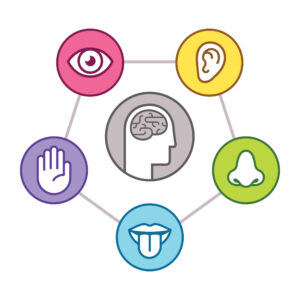If you’re connected to the autism community, you are likely aware of sensory differences, which are so common in the autistic population that they were added to the most recent diagnostic criteria for autism. Sensory differences are common in people with other diagnoses as well, such as people with developmental disabilities, ADHD, sensory processing disorders, mental health conditions, and dementia, among others. Sensory processing, or the way our nervous systems take in and make sense of information from the environment through our senses, is part of the human experience for each and every one of us. So, no matter who you are, an understanding of sensory processing is directly relevant to you. If you are or support a person with sensory differences, it is particularly important to be aware of sensory processing when considering accommodations and modifications that can be made to increase access to daily spaces and activities. In this blog, we’ll review the major sensory systems (including a few you might not be familiar with), and then we’ll look at some common patterns of sensory responses (“sensory profiles”).
 What are the senses?
What are the senses?
When thinking about sensory processing and sensory differences, it’s helpful to first have a basic understanding of the senses we all use every day. At any given time, we are each receiving and processing information through our sensory system to generate an awareness of the environment around us and determine how to interact with that environment. Each person’s unique sensory system determines the way they perceive and engage with the world. So, what senses are we using for this important task?
Visual
The visual system receives input that comes in through the eyes and is related to seeing. Visual information includes color, shape, orientation, motion, and brightness.
Auditory
The auditory system receives input that comes in through our ears and is related to hearing. Auditory information includes pitch, tone, and amplitude (volume).
Tactile
The tactile system receives input through receptors in the skin and is related to touch. Tactile information includes touch, pressure, flutter, and vibration. Temperature and pain sensations are also integrated with tactile sensations within the brain.
Smell
The olfactory system receives input through receptors in your nose and is related to smell. This system allows us to identify odors. It also teams up with our sense of taste to allow us to experience flavors.
Taste
The gustatory system receives input through receptors in your mouth and throat and is related to taste. We can detect 5 basic tastes: sweet, salty, bitter, sour, and umami (savory).
Proprioception
The proprioceptive system receives information through receptors in muscles and joints and is related to movement and body position. Proprioceptive information includes muscle length, muscle tension, joint pressure, and joint angle. Proprioceptive input comes from moving our bodies into different positions and using our muscles to push, pull, stretch, squeeze, bump, and otherwise exert force (or have force exerted upon us).
Vestibular
The vestibular system receives input through the inner ear and is related to movement and balance. Vestibular information includes rotation, linear movement (side to side, up and down, front and back), and the position of our head relative to gravity. We get input through this sense when we do things like swing, rock, spin, jump, wiggle back and forth, or even walk.
Interoception
The interoceptive system receives input through receptors in internal organs and membranes and is related to internal sensations. Interoception is the sense that allows us to detect hunger, thirst, heart rate, breathing rate, when we need to use the bathroom, etc. These types of internal sensations are also connected to our experience of emotions.
What are sensory differences and who has them?
We all respond to sensory information from our environments, and no two of us respond in exactly the same way. Some of us love spicy foods, while others prefer bland. Some people love active play, and some would rather sit and read. Sensory sensitivities and preferences are part of the human experience, but some people tend to have more pronounced differences in their sensory responses.
Dr. Winnie Dunn’s Sensory Processing Model outlines two key continuums of responses to sensory input, which interact to create four primary “sensory profiles.” The first continuum, Neurological Threshold, is related to perception of sensory information (how much sensory input is required to reach the threshold for a person to consciously notice it). The second continuum, Self-Regulation, is related to a person’s tendency to be more active or more passive in their response to over- or under-stimulation. The four “profiles” are described below.
Sensory Avoiding
Sensory avoiding individuals are hypersensitive (over responsive) to sensory input, and they actively avoid aversive sensory experiences (Dean et al., 2022). This might look like someone plugging their ears in response to loud noises, running out of a crowded space, or moving away from someone who touches them unexpectedly.
Sensory Sensitivity
Sensory sensitive individuals are also hypersensitive (over responsive) to sensory input, but they are more passive in their self-regulation style (Dean et al., 2022). This means they often experience internal discomfort without taking action to avoid aversive sensory input. A sensory sensitive person might not outwardly appear to be in distress, but they may be unable to engage in overstimulating environments.
Sensory Seeking
People who are sensory seeking need a higher level of sensory input to feel regulated, and they actively seek out that additional input through sensory experiences (Dean et al., 2022). A sensory seeker might engage in a lot of movement (jumping, spinning, running, rocking), they may be really drawn to things they can spin or toss and watch fall, or they might love listening to multiple sources of audio simultaneously.
Low Registration
Individuals with low registration also need a higher level of sensory input, but they do not actively seek it out (Dean et al., 2022). This means that they might have a low level of alertness to environmental cues and may miss information. A person with a low registration profile might seem to be sleepy, zoned out, or unengaged. They might not notice information that seems apparent about how to participate in a space or activity without additional cues.
Many people have some combination of these profiles. For example, a person may be sensitive to particular sounds and visual input but seek out proprioceptive input through hugs and crashing into things. Often, individuals with sensitivities to particular types of input seek out other, more preferred types of input as a strategy to block out the aversive ones. These quadrants in Dunn’s model are not fixed boxes that individuals must fit into, but they can be helpful for understanding how different people may relate to sensory aspects of the environment and ways we can support people to access different spaces and activities.
For many in the autistic community, accommodations and support for sensory processing differences are a crucial part of enabling access and engagement in daily life. For help to assess sensory needs and explore supportive tools and strategies, consider consulting with a licensed occupational therapy practitioner in your area.
About the Author
Cassie Fraser-Ball is an occupational therapist, currently practicing in a public school setting with a focus on adolescents and assistive technology. She is passionate about supporting individuals to develop community access, daily living skills, and personally meaningful roles and routines as they enter adult life. Cassie has supported autistic individuals and their families for over a decade in a variety of different professional roles, many of which were through the Autism Society of NC. She currently serves ASNC as an occupational therapy consultant.
ASNC’s Clinical Department helps individuals with autism increase independence and improve communication skills. We offer Applied Behavior Analysis (ABA) services through our LifeLong Interventions program. Our ABA treatment promotes meaningful skills and behaviors in the home, school, and community, such as increased communication, improved attention at school or work, self-care, and calming strategies. Short-Term Clinical Consultation is a statewide telehealth service for children and adults that provides tips and strategies to address communication, behavior intervention, and other needs. We offer Behavior Consultation to help explain why behaviors are occurring, develop comprehensive behavior plans, and coach caregivers on effective strategies. We also deliver workshops and trainings to parents and professionals on a wide range of topics such as strategies to respond to behaviors, best practices in early intervention, and improving communication and social understanding in individuals with autism. You can connect with the Clinical Department by clicking here and filling out our form.
References
Dean EE, Little L, Tomchek S, Wallisch A and Dunn W (2022) Prevalence Models to Support Participation: Sensory Patterns as a Feature of All Children’s Humanity. Front. Psychol. 13:875972. doi: 10.3389/fpsyg.2022.875972
Tags: autism, autism behavior, autism resources, autism senses, Developmental disability, sensory differences, sensory issues, sensory processing, sensory profiles, sensory responses, sensory sensitivity Go back

